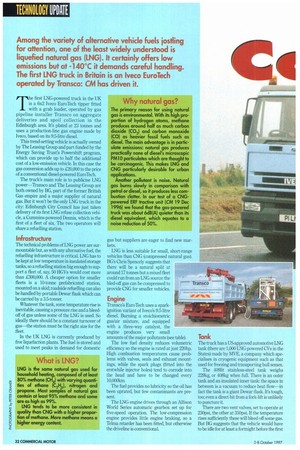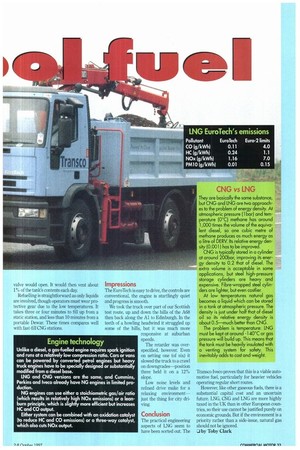T i e first LNG-powered truck in the UK s a 6x2
Page 34

Page 35

If you've noticed an error in this article please click here to report it so we can fix it.
Iveco EuroTech tipper fitted with a grab loader, operated by gas pipeline installer Transco on aggregate deliveries and spoil collection in the Edinburgh area. It's plated at 23 tonnes and uses a production-line gas engine made by Iveco, based on its 9.5-litre diesel.
This trend-setting vehicle is actually owned by The Leasing Group and part-funded by the Energy Saving Trust's Powershift program, which can provide up to half the additional cost of a low-emission vehicle. In this case the gas conversion adds up to £20,000 to the price of a conventional diesel-powered EuroTech.
The truck's main role is to publicise LNG power—Transco and The Leasing Group are both owned by BC, part of the former British Gas empire and a major supplier of natural gas. But it won't be the only LNG truck in the city: Edinburgh City Council has just taken delivery of its first LNG refuse collection vehicle, a Cummins-powered Dennis, which is the first of a fleet of six. The two operators will share a refuelling station.
Infrastructure
The technical problems of LNG power are surmountable but, as with any alternative fuel, the refuelling infrastructure is critical. LNG has to be kept at low temperature in insulated storage tanks, so a refuelling station big enough to support a fleet of, say, 50 HGVs would cost more than £300,000. A cheaper option for smaller fleets is a 10-tonne prefabricated station, mounted on a skid; roadside refuelling can also be handled by portable Dewar flask which can be carried by a 3.5-tonner.
Whatever the tank, some temperature rise is inevitable, causing a pressure rise and a bleedoff of gas unless some of the LNG is used. So ideally there should be a constant turnover of gas—the station must be the right size for the fleet.
In the UK LNG is currently produced by five liquefaction plants. The fuel is stored and used to meet peaks in demand for domestic
gas but suppliers are eager to find new markets.
LNG is less suitable for small, short-range vehicles than CNG (compressed natural gas). BC's Chris Spencely suggests that there will be a natural split at around 17 tonnes but a mixed fleet could run from an LNG source: the bled-off gas can be compressed to provide CNG for smaller vehicles.
Engine
Transco's EuroTech uses a sparkignition variant of Iveco's 9.5-litre diesel. Burning a stoichiometric gas/air mixture, and equipped with a three-way catalyst, the engine produces very small amounts of the major pollutants (see table).
The low fuel density reduces volumetric efficiency so the engine is rated at just 220hp. High combustion temperatures cause problems with valves, seals and exhaust mountings, while the spark plugs (fitted into the erstwhile injector holes) tend to corrode into the head and have to be changed every 10,000km.
The fuel provides no lubricity so the oil has been uprated, but few contaminants are present.
The LNG engine drives through an Allison World Series automatic gearbox set up for five-speed operation. The low-compression engine provides little engine braking, so a Telma retarder has been fitted, but otherwise the driveline is conventional.
Tank
The truck has a US-approved automotive LNG tank (there are 1,000 LNG-powered CVs in the States) made by MVE, a company which specialises in cryogenic equipment such as that used for freezing and transporting bull semen.
The 4091it stainless-steel tank weighs 229kg, or 408kg when full. There is an outer tank and an insulated inner tank: the space in between is a vacuum to reduce heat flow—in fact the tank is a giant Dewar flask. It's tough, too; even a direct hit from a fork-lift is unlikely to puncture it.
There are two vent valves, set to operate at 230psi, the other at 350psi. If the temperature rises sufficiently these will bleed off some gas. But BC suggests that the vehicle would have to be idle for at least a fortnight before the first valve would open. It would then vent about 1% of the tank's contents each day Refuelling is straightforward as only liquids are involved, though operators must wear protective gear due to the low temperatures. It takes three or four minutes to fill up from a static station, and less than 10 minutes from a portable Dewar, These times compares well with fast-fill CNG stations.
Impressions
The EuroTech is easy to drive, the controls are conventional, the engine is startlingly quiet and progress is smooth.
We took the truck over part of our Scottish test route, up and down the hills of the A68 then back along the Al to Edinburgh. In the teeth of a howling headwind it struggled up some of the hills, but it was much more responsive at suburban speeds.
The retarder was overspecified, however. Even on setting one (of six) it slowed the truck to a crawl on downgrades—position three held it on a 12% slope.
Low noise levels and refined drive make for a relaxing environment just the thing for city driving.
Conclusion
The practical engineering aspects of LNG seem to have been sorted out. The Transco lveco proves that this is a viable automotive fuel, particularly for heavier vehicles operating regular short routes.
However, like other gaseous fuels, there is a substantial capital cost and an uncertain future. LNG. CNG and LNG are more highly taxed in the UK than in other European countries, so their use cannot be justified purely on economic grounds. But if the environment is a priority rather than a side-issue, natural gas should not be ignored.
by Toby Clark








































































































